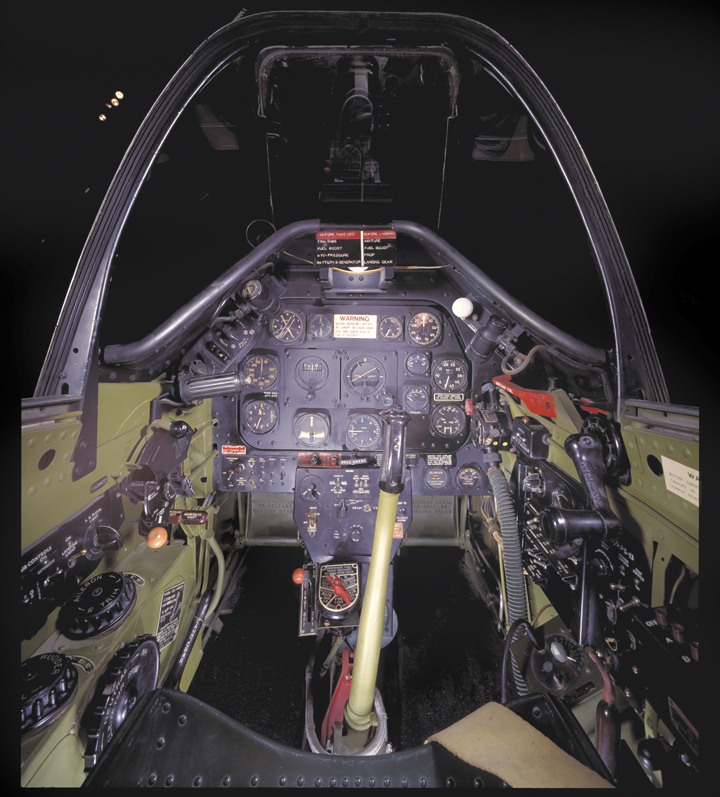The Smithsonian’s National Air and Space Museum memorializes the national development of aviation and space flight. The museum maintains the largest - more than 33,500 objects - and most diverse collection of historic air and spacecraft in the world. For more information, please visit www.nasm.edu.Each year, SITES shares the wealth of Smithsonian collections and research programs with millions of people outside of Washington, D.C. One of the Smithsonian’s four National Programs, SITES makes available a wide range of exhibitions about art, science and history, which are shown not only in museums but also wherever people live, work and play, including libraries, science centers, historical societies, community centers, botanical gardens, schools and shopping malls.

|
The P-51 Mustang was considered the finest fighter plane of World War II. Inside the cockpit, the gun trigger is on the control stick (lower center) and the canopy ejection control is the horizontal level on the right (right center of photo). |
“AT THE CONTROLS: The Smithsonian’s Air & Space Museum Looks At Cockpits”
January 05, 2007
New traveling exhibit from the Smithsonian Air & Space Museum at California Oil Museum Feb. 11
Santa Paula News
The new traveling exhibit from the Smithsonian Air & Space Museum, “At The Controls,” will open with a reception from 1 to 3 PM, Sunday, February 11, 2007, at the City of Santa Paula’s California Oil Museum (1001 E. Main St., Santa Paula, 805-933-0076, $4 Adults, $3 Seniors, $1 Children). All are welcome and refreshments will be served. The exhibit presents extraordinary 4- by 7-foot color images of the cockpits of the world’s most famous aircraft and space vehicles (http://www.sites.si.edu/exhibitions/exhibits/controls/main.htm). The Oil Museum is adding an additional component to the exhibit, an Aviation Cockpit Demonstrator from the NASA Langley Research Center in Virginia. The exhibit runs through Sunday, June 24, 2007.
The “At the Controls” exhibition features 20 large-format color photographs of historically significant cockpits, such as the Wright brothers’ 1903 Flyer; the “Enola Gay,” a Boeing B-29 Superfortress; the Mercury “Friendship 7”; and the space shuttle “Columbia” (a complete list is below). Using a 4 by 5 camera with 120-degree wide-angle lens and a variety of lighting techniques, photographers Eric F. Long and Mark Avino have created unique images that contrast the simplicity and complexity of cockpits throughout aviation history.Measuring approximately 4 by 7 feet, the images depict in rich and precise detail the evolution of the controls, instruments and displays used to fly these air and spacecraft. The cockpits in the exhibition were selected because their instrumentation panels vividly illustrate the development and refinement of aviation technology. Additional information and complete views of the air and spacecraft accompany each photograph.The Aviation Cockpit Demonstrator from the NASA Langley Research Center will enable visitors to see what it is like to fly a plane, even in bad weather. The one-seat interactive demonstrator incorporates NASA’s weather-in-the-cockpit technology and is handicapped-accessible (http://oea.larc.nasa.gov/Exhibits/details.cfm?id=222).A companion to the exhibition, At the Controls: The Smithsonian National Air and Space Museum Book of Cockpits edited by Thomas M. Alison and Dana Bell, includes forty-five of these images of aviation cockpits. The book is available through Boston Mills Press ($39.95).“At the Controls: The Smithsonian’s National Air and Space Museum Looks at Cockpits” was developed by SITES and the Smithsonian’s National Air and Space Museum. Eric Long is a senior photographer for the Smithsonian’s Office of Imaging, Printing, and Photography at the National Air and Space Museum. During his 19-year career at the Smithsonian Institution, he has documented collections, exhibits and events for museum research and publications, and has participated in historical documentations including three presidential inaugurations and an oral history of Southern agriculture. Mark Avino is a chief photographer for the Office of Imaging, Printing, and Photography at the Air and Space Museum. Also with the Smithsonian Institution for 19 years, Avino has directed and supervised staff photographers who specialize in reproduction and documentation of the museum’s collections, created exhibition displays, and arranged special research and publications events. Avino has also served as guest speaker and judge for Gallaudet University Department of Photography photo contests.


